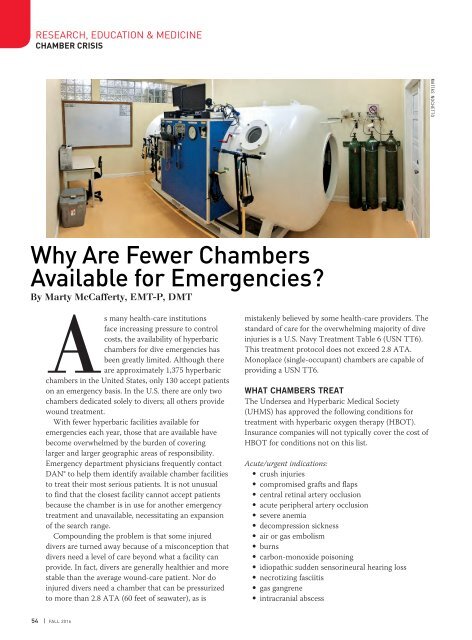AD 2016 Q4
Alert Diver is the dive industry’s leading publication. Featuring DAN’s core content of dive safety, research, education and medical information, each issue is a must-read reference, archived and shared by passionate scuba enthusiasts. In addition, Alert Diver showcases fascinating dive destinations and marine environmental topics through images from the world’s greatest underwater photographers and stories from the most experienced and eloquent dive journalists in the business.
Alert Diver is the dive industry’s leading publication. Featuring DAN’s core content of dive safety, research, education and medical information, each issue is a must-read reference, archived and shared by passionate scuba enthusiasts. In addition, Alert Diver showcases fascinating dive destinations and marine environmental topics through images from the world’s greatest underwater photographers and stories from the most experienced and eloquent dive journalists in the business.
Create successful ePaper yourself
Turn your PDF publications into a flip-book with our unique Google optimized e-Paper software.
RESEARCH, EDUCATION & MEDICINE<br />
CHAMBER CRISIS<br />
MATÍAS NOCHETTO<br />
Why Are Fewer Chambers<br />
Available for Emergencies?<br />
By Marty McCafferty, EMT-P, DMT<br />
As many health-care institutions<br />
face increasing pressure to control<br />
costs, the availability of hyperbaric<br />
chambers for dive emergencies has<br />
been greatly limited. Although there<br />
are approximately 1,375 hyperbaric<br />
chambers in the United States, only 130 accept patients<br />
on an emergency basis. In the U.S. there are only two<br />
chambers dedicated solely to divers; all others provide<br />
wound treatment.<br />
With fewer hyperbaric facilities available for<br />
emergencies each year, those that are available have<br />
become overwhelmed by the burden of covering<br />
larger and larger geographic areas of responsibility.<br />
Emergency department physicians frequently contact<br />
DAN® to help them identify available chamber facilities<br />
to treat their most serious patients. It is not unusual<br />
to find that the closest facility cannot accept patients<br />
because the chamber is in use for another emergency<br />
treatment and unavailable, necessitating an expansion<br />
of the search range.<br />
Compounding the problem is that some injured<br />
divers are turned away because of a misconception that<br />
divers need a level of care beyond what a facility can<br />
provide. In fact, divers are generally healthier and more<br />
stable than the average wound-care patient. Nor do<br />
injured divers need a chamber that can be pressurized<br />
to more than 2.8 ATA (60 feet of seawater), as is<br />
mistakenly believed by some health-care providers. The<br />
standard of care for the overwhelming majority of dive<br />
injuries is a U.S. Navy Treatment Table 6 (USN TT6).<br />
This treatment protocol does not exceed 2.8 ATA.<br />
Monoplace (single-occupant) chambers are capable of<br />
providing a USN TT6.<br />
WHAT CHAMBERS TREAT<br />
The Undersea and Hyperbaric Medical Society<br />
(UHMS) has approved the following conditions for<br />
treatment with hyperbaric oxygen therapy (HBOT).<br />
Insurance companies will not typically cover the cost of<br />
HBOT for conditions not on this list.<br />
Acute/urgent indications:<br />
• crush injuries<br />
• compromised grafts and flaps<br />
• central retinal artery occlusion<br />
• acute peripheral artery occlusion<br />
• severe anemia<br />
• decompression sickness<br />
• air or gas embolism<br />
• burns<br />
• carbon-monoxide poisoning<br />
• idiopathic sudden sensorineural hearing loss<br />
• necrotizing fasciitis<br />
• gas gangrene<br />
• intracranial abscess<br />
54 | FALL <strong>2016</strong>










